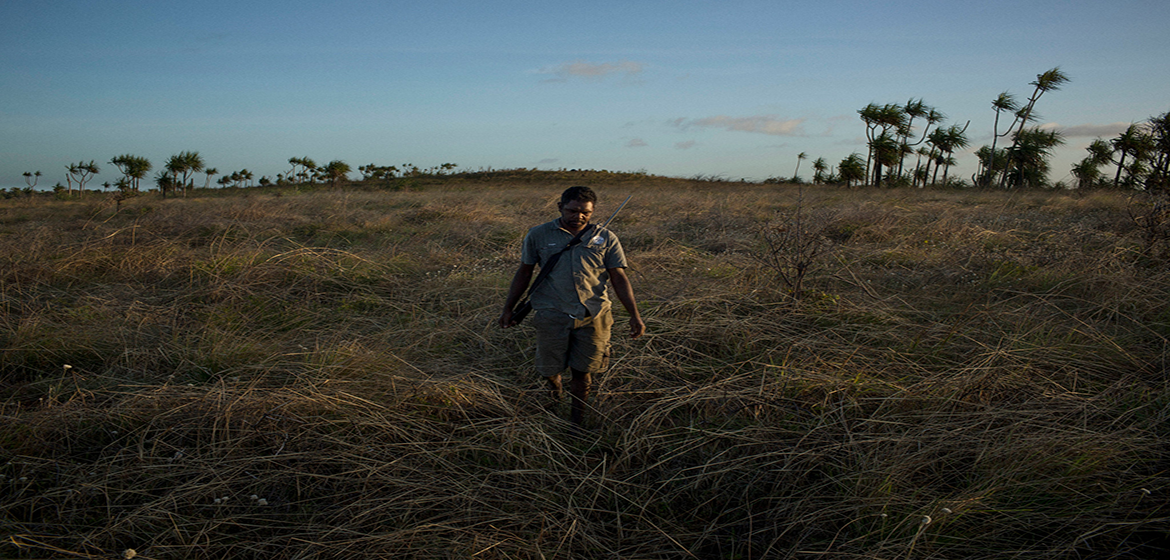Photographs and Text by David Maurice Smith
YALANGBARRA, Australia — As the sun dropped below the horizon and darkness spread across the vast Northern Territory sky, the men and women scanned the terrain one last time for potential prey.
It was dinnertime for the Dhimurru Rangers, a group of mostly Indigenous Australians who had spent a long day cleaning up the polluted beaches of the continent’s northern coast. Soon they would be eating freshly caught fish and seafood cooked under the stars on an open fire, as their ancestors did.
For thousands of years, the Yolngu Aboriginal people have lived in this part of Australia, hunting in its forests and fishing in its waters.
But this once unspoiled land is now polluted. Thousands of pounds of plastic garbage wash up here annually and so-called ghost nets — abandoned nylon fishing trawls — entangle and kill endangered animals including sea turtles, dugongs and sharks.
![]()
The rangers look after 3,300 square miles of land and sea in Arnehm Land in the Northern Territory.CreditDavid Maurice Smith for The New York Times
![]()
Each day, waves deposit tons of trash on the beach.CreditDavid Maurice Smith for The New York Times
The Dhimurru Rangers are one of more than 100 Indigenous groups spread across the continent who have taken on the job of protecting the land of their forebears, combining traditional methods with contemporary conservation.
In Arnhem Land along the Gulf of Carpentaria, they are the heirs and stewards of 3,300 square miles of land and sea.

By The New York Times
They painstakingly comb the beaches by hand, picking up as much debris as possible. The task is Sisyphean as each day delivers literal waves of new trash.
For the rangers, cleaning the beaches is more than a vocation. For a people whose culture is indelibly tied to the land, protecting the environment is tantamount to preserving their history.
“Being a ranger is about protecting our own country,” said Gatha Pura Munnunggurr, 28. “If you lose your culture you’re nothing.”

Debris, much of it plastic from Indonesia, has washed up on the shores of Bremmer Island, off the coast of northern Australia.CreditDavid Maurice Smith for The New York Times
On a particularly challenging day in July, the rangers worked to dispose of a gigantic ghost net. The seemingly endless net, lost or abandoned by fishermen likely from Indonesia, had become partially buried close to shore.
Even an old, torn net is still capable of ensnaring fish and wildlife. The rangers used all the tools at their disposal — power tools, a truck’s cable winch, even the tides themselves — to remove the net, which was hundreds of meters long and buried several feet under water and sand.
The rangers raced against the rising tide and setting sun, but called it quits when the waters rose above their ankles. The net would still be there tomorrow and they would try again then.
For many Aboriginal Australians, colonization forcefully broke their connection to the land generations ago. Indigenous people were displaced and their cultural practices outlawed.

Sharks, like this whale shark, are among the creatures most commonly caught in so-called ghost nets, lost or abandoned fishing skeins.CreditDavid Maurice Smith for The New York Times

The rangers connecting cables to a truck’s winch to dislodge a ghost net buried in the sand.CreditDavid Maurice Smith for The New York Times
Tens of thousands of years of traditional land management ended, and as a result many parts of the country now face serious degradation from invasive plant and animal species, bush fires and land mismanagement.
In recent years, the government has restored more than 20 percent of the country’s land — some of it former parks and reserves — to Indigenous owners. Since 2007, the Indigenous ranger organizations have been at work protecting this land.
Luke Playfair, one of the few non-Indigenous employees working with the rangers, said the combination of old and new techniques and an appreciation for Indigenous’ workers cultures has been critical to the program’s success.

Mr. Mununggurr and Rrawun Maymuru, right, going hunting and fishing after a day’s work.CreditDavid Maurice Smith for The New York Times

Mandaka Marika and his wife, Daylulu, sitting by a fire at dusk after a day of cleanup on the beaches.CreditDavid Maurice Smith for The New York Times
“You are working with staff who see the world different to you so there is a much higher focus on the cultural aspects of work and life,” he said.
Rangers are given “cultural leave,” he added, if they need to visit their homelands after the death of a community member, or to make long journeys home to remote areas.
On the beach that day in July, after their unsuccessful struggle with the ghost net, the rangers lit a camp fire and stared out at the same sea and sky that had inspired their ancestors most sacred stories.
“Being a ranger is a source of confidence, you feel strong,” said Terence Wunungmurra, a senior ranger. “Here we still live on the land. The culture is still alive.”

The rangers find comfort in knowing the stars are the same as those that illuminated the skies of their ancestors.CreditDavid Maurice Smith for The New York Times
Source:
Related to SDG 13: Climate action and SDG 15: Life on land



